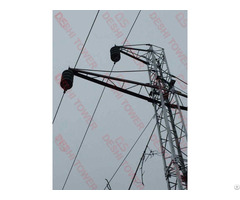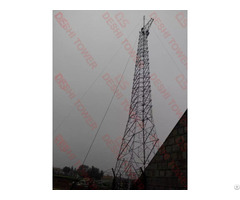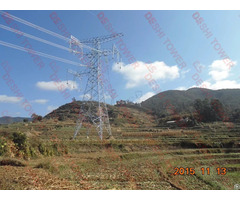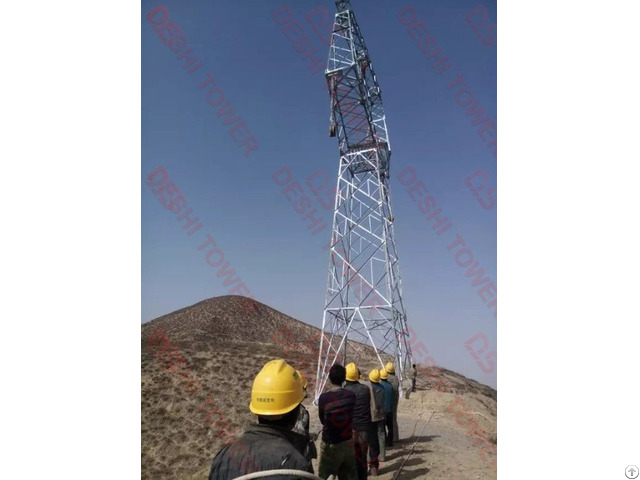V Type Transmission Line Tower - China
price: contact company for price
V-type transmission line tower is specifically designed for scenarios where electrical power lines need to split or branch off in different directions.
This design features a distinctive “V” shape at the top, which helps to support and separate the diverging power lines effectively.
These towers are crucial for maintaining the structural integrity and safety of power transmission networks, especially at junction points where lines diverge.
Key Characteristics of V-type Transmission Line Towers
Design and Structure: The tower’s structure expands into a “V” shape at the top, where the power lines are mounted.
This design allows for the physical separation of lines that are heading in different directions, reducing the chance of electrical interference and providing clear physical pathways for each line.
Material: Similar to other types of transmission towers, V-type towers are primarily constructed from galvanized steel or aluminum to resist corrosion and withstand environmental factors like wind, rain, and temperature variations.
Height and Load: The height of these towers can vary significantly based on the voltage of the lines and the geographical layout of the area.
They are engineered to carry the mechanical load of the cables, which can be substantial at branching points due to the additional tension from multiple directions.
Foundation: The foundation of a V-type tower is designed to handle not only the vertical loads from the tower and the cables but also the asymmetrical loads that occur because the cables pull in different directions.
Applications of V-type Transmission Line Towers
Network Expansion: V-type towers are essential for expanding power transmission networks, especially in areas where new lines need to branch off from main transmission routes to reach new regions or power distribution centers.
Flexibility in Line Routing: They provide flexibility in the routing of power lines, allowing utilities to optimize the paths of transmission lines based on geographic and environmental considerations.
Urban and Rural Power Distribution: In urban areas, where space is limited, and in rural areas, where lines might need to branch to cover more area, V-type towers facilitate effective distribution without requiring multiple parallel towers.
Advantages
Efficient Use of Space: By facilitating multiple line directions from a single tower, the V-type design reduces the need for additional towers and minimizes land use.
Reduced Electrical Interference: The physical separation of lines at the branching points helps in minimizing electrical interference, which is crucial for maintaining the stability and efficiency of the power transmission.
Enhanced Safety and Reliability: The design ensures that even if one line fails, the structure can support the remaining lines, enhancing the overall reliability of the power transmission network.
Installation Considerations
Installing a V-type tower requires careful planning to ensure that all forces are balanced and the foundation is capable of supporting the asymmetrical loads.
It’s also essential to consider future expansion and maintenance access during the initial design and placement of these towers.
V-type towers are a critical component in the design and implementation of complex power transmission networks, providing a robust solution for managing the physical and electrical challenges associated with branching transmission lines.
Product v type transmission line tower
Shape lattice
Material Normally Q345B/A572, Minimum Yield Strength ≥ 345 N/mm² Q235B/A36, Minimum Yield Strength ≥ 235 N/mm².
OR Q420 Q460 ASTM A572 GR65, GR50, SS400
Electric Voltage 10kv, 11kv, 32kv, 33kv, 35kv, 65kv, 66kv, 90kv, 92kv, 110kv, 115kv, 132kv, 220kv, 230kv, 300kv, 320kv, 330kv, 345kv, 380kv, 400kv 500kv, 750kv, 765kv, 800kv, 850kv, 1000kv, 1100kv
Surface treatment Hot dip galvanized Following ASTM A 123, BS729 or as client required.
connection bolt connection
Standard ISO 9001: 2008
Height: below 60 meters
Surface treatment: galvanization and color painted
Welding Standard AWS (American Welding Society ) D 1.1
Production Process Raw material test → Cutting →Welding →Hole drilling →Dimension verify →sample assemble → surface clean→ Galvanization or powder coating, painting →Recalibration →Packages
Packages Packing with plastic paper, steel box or according to client’s request.
Deshi Tower specializes in the design, manufacture, and construction support of transmission towers, communication towers, steel structures, and observation towers.
Transmission tower design adheres to ASCE/SEI standards.
Telecommunication tower design follows ANSI/TIA-222 standards.
We are not just manufacturers and suppliers, but also your technical support and partners.
Company Contact:
- Posted By: Deshi Industry
- Phone: +865368666318
- Address: No.322 YinfengRoad, weifang , china , China
- Email:

- Website: https://deshiindustry.com
Published date: June 17, 2024
- Business Description: Design, Manufacturing, and Construction Support for Transmission Towers, Telecom Towers, Steel Structure Buildings, Weather tower, Observation Towers, Microwave Towers, and Lightning Towers.
Related listings
-
 Lattice PolesElectrical Utilities - Deshi Industry - China - June 17, 2024 - contact company for price
Lattice PolesElectrical Utilities - Deshi Industry - China - June 17, 2024 - contact company for priceLattice poles in the context of electrical power transmission and distribution are specific types of structures designed to support overhead power lines. These poles are characterized by their openwork metal frame structures, which are typically made...
-
 110kv Electrical TowerElectrical Utilities - Deshi Industry - China - June 17, 2024 - contact company for price
110kv Electrical TowerElectrical Utilities - Deshi Industry - China - June 17, 2024 - contact company for priceFor 110kV electrical towers, which are commonly used in medium-high voltage transmission systems, here are the key considerations: Structural Design and Specifications: Towers for 110kV lines need to support higher voltage levels and heavier loads co...
-
 Overhead Line TowerElectrical Utilities - Deshi Industry - China - June 17, 2024 - contact company for price
Overhead Line TowerElectrical Utilities - Deshi Industry - China - June 17, 2024 - contact company for priceAn overhead line tower, also known as a transmission tower or electricity pylon, is a tall structure used to support overhead power lines. These towers are crucial for transmitting electrical energy over long distances from power generation facilitie...
Safe Trade Tips
- Ask for business references and check them
- Use a payment method that offers better protection for all such as Letters of credit and verified professional escrow services. Avoid payments in advance such as money transfers
- Verify their business via their local Chamber of Commerce
- Search the internet using their website address, their business name, their phone and fax numbers, and their email addresses to see if you can find any feedback about them.
- Get to know more about scams and fraud to avoid: Internet Crime Complaint Center - Consumer Financial Protection Bureau
- This site is never involved in any transaction, and does not handle payments, shipping, guarantee transactions, provide escrow services, or offer "buyer protection" or "seller certification"
